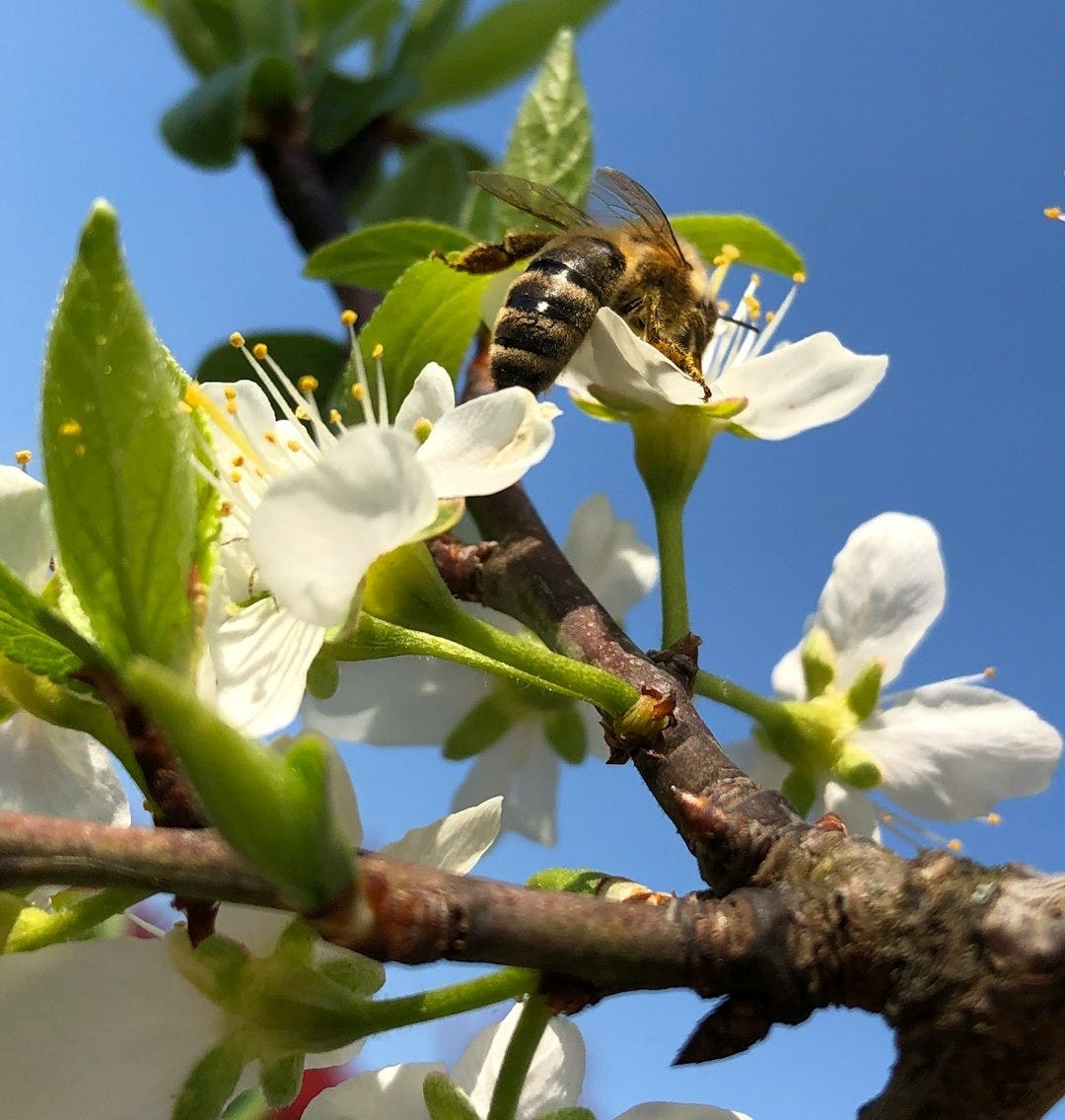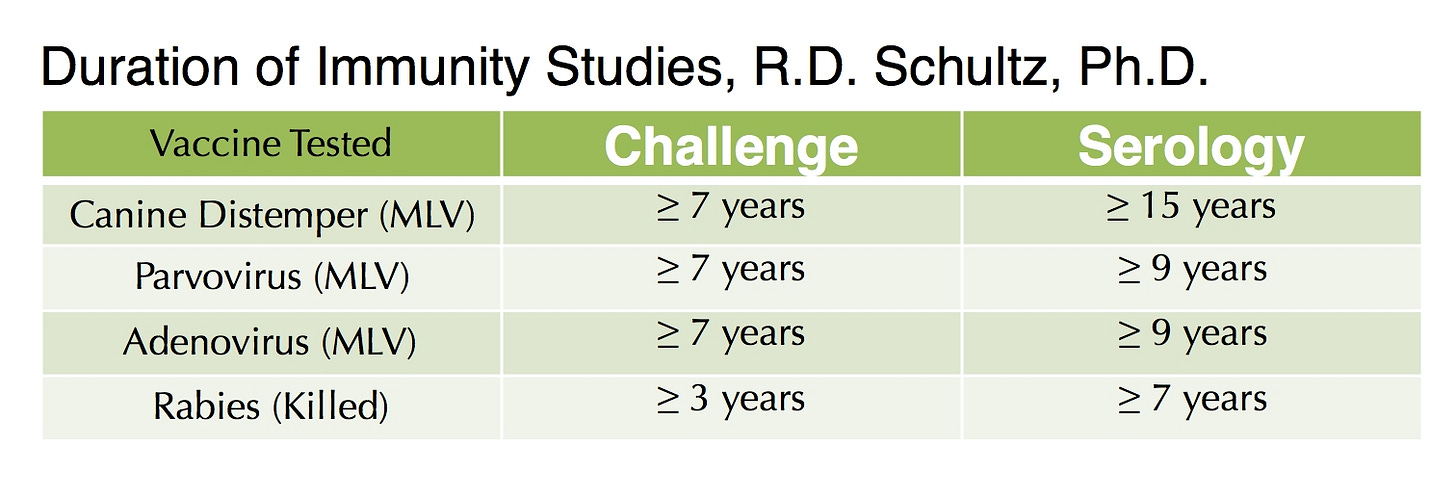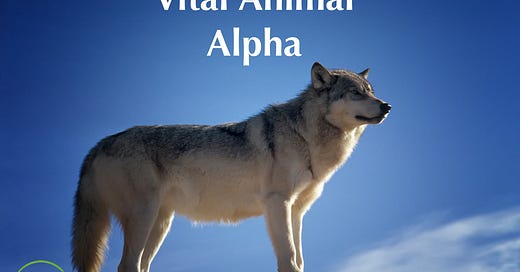Vital Animal News: April 20, 2025
Treatment Making Things WORSE / Alpha Closing / Bee Decline: US only? / Raccoon Distemper / Elephant Instincts / A Surgery Remedy (Caution) / and MORE
When Treatment Seems to Work
Alpha Enrollment Ends Tonight
Bees, Fleas, and Thee
Raccoon Distemper: Fearful or Boon?
Elephants & Earthquakes
Tasty Tip: Surgery Remedy
Along the Natural Path
When Treatment Worsens the Patient
Here’s a homeopathy case I shared with my Alpha members a while back.
A poor little Chihuahua plagued with the #1 reason dogs get brought to vets: The Itch.
I asked a simple question: “After reading the first sentence of this case, tell me what you think happened to this little Chi?”
[Here's the first sentence: "Matilda is a 13-year-old Chihuahua who was put on Prednisone 10 years ago for severe itching, and then on Phenobarbital 2 years ago for seizures."]
In addition to studying acute prescribing for animals, my Alpha members get a broad background to help understand the workings of homeopathy.
One of the many things we discuss in the membership course:
What are the possible outcomes for ANY treatment, natural or allopathic?
Disease outcomes: Only 3 are possible
What ever the treatment, from drugs to surgery to acupuncture to herbs to supplements to homeopathy, if we carefully evaluate, we’ll see one of these three results in every single case:
Cure
Palliation
Suppression
I touch on this in two episodes of the Vital Animal Podcast, # 24 and # 20 Each has an interesting homeopathic case from my own practice.
You can listen to those later, but stay with me here, now.
Here’s a quick review of each possible outcome.
--Cure: the complete resolution of the disease, where the patient not only loses their symptoms but improves broadly and stays that way without the continued use of medicines or treatments.
Obviously, this is what you’d want for any animal, child, or yourself when sickness strikes, right?
--Palliation: the patient is somewhat better while on the medicine, but it cannot be stopped, or symptoms return. There’s clearly no deeper, broader improvement, just symptom subsidence.
The hidden reality is that, while under any palliative treatment, the chronic disease is gradually worsening. That often means drug doses need to increase or “stronger” drugs (like antibiotics) are employed over time.
--Suppression: the symptoms disappear quickly but things get more serious as the disease hasn’t been cured.
Surgery of a diseased organ is the classic example of the last one.
I shared a suppression case a few years back on my blog post, Tumor, But No Surgery? What Will People Think??
In that case, a benign (but admittedly unsightly) tumor was tossed into the waste bin (against my advice, but the husband “won”).
A couple months later, the dog lost control of her rear limbs. Permanently.
So, which of these won the prize for my students?
Susan King, one of my long time Alpha students got it right: It was palliation.
The treatment (10 long years of steroids, palliating the itch) caused the seizures.
The two diseases are related in this case, though I doubt if anyone in conventional medicine would see the connection.
When you push a disease into a dark corner like the steroids did, it’s not gone.
Symptoms were hidden, sure.
But the disease continued to smolder.
And finally, the patient paid the price with a much more serious manifestation: epilepsy.
Far deeper, far more life threatening than disease that’s on the surface and merely bothersome and itchy, right?
Luckily, in this case, it appears a second remedy, used a few judicious times, cured her.
This is exceptional, in my experience.
The far more normal outcome for epilepsy would be needing several different prescriptions over time (always one at a time, however).
So, what’ll it be for you and yours?
Cure, palliation, or suppression?
Conventional medicine cannot cure disease. It's not built that way, and that's painfully apparent in chronic cases like The Itch.
If you want to seek a homeopathic practitioner, I've got a video on how to best choose a qualified one on my Recommended Resources page.
Alpha Closing tonight
We’ve been excitedly welcoming our new members in Vital Animal Alpha over the past few days of open enrollment.
While the core focus of our membership group is acute veterinary homeopathy, we are also given to discussing all things natural health.
Our live monthly Q/A meeting on Thursday evening found us discussing:
Raw food for kidney failure cats
Nosodes for a pup when her littermates will be shedding vaccine viruses
Separation anxiety, which hasn’t yet yielded to professional prescribing
A cat who pulls hair out only on one side of his body
A surprising poison ivy cure with a remedy chosen for something else entirely
Feral cats with “pillow paws”
Remedies to employ after dental extractions
Our private (non-Facebook) discussion group is always active, and we’re saying Hey to our new members, who are starting to dig into the acute prescribing lesson library.
Enrollment Closing Tonight
If you’ve thought about joining us, our open enrollment period is coming to a close (tonight, Sunday @ midnight CT).
Here’s where you can get more details and join us:
Bees, Fleas, and Thee

You’ve likely read over the years how our bee populations are in trouble.
And how a large percentage of our food crops depend on these tiny pollinators.
No bees? No almonds, for example.
It turns out, this is uniquely a problem in the US (where have we heard this before? Food colors, glyphosate, etc.)
This article reveals bee populations in South America, China and Africa are actually on the uptick!
Why US?!
The wide spread use of a pesticide class called neonicotinoids (or “neonics”) is often found to be a direct killer of our friendly flying pollinators.
Banned in Europe, banned in Canada, but not in the good ole U.S. of A.
The Chicago Bird Alliance has this to say about these nicotine derivatives:
“A single seed coated with a neonic can kill a field sparrow, and a 1/10th of a treated coated seed can impair a bird’s reproduction. Sometimes called the ‘bee killing pesticide’, neonics are often cited as one of the main causes of declining bee populations.
Neonics are applied as an insecticidal seed coating on millions of acres of field crops, including virtually all commercial corn and half of soybeans grown in the United States. It is also applied to turf grass, ornamental plants and nursery trees. The coating renders plants – including their roots, leaves, stem, flowers, nectar, and pollen - toxic to insects.
If you Garden…
The Center for Food Safety has you covered on those nasties appearing in your local garden centers.
They offer a downloadable list that interestingly, Bayer seems to dominate. (You may remember Bayer purchased Monsanto (maker of RoundUp) some years back.)
Pet Sources. Oh Oh.
You likely know if you’ve followed along for some time, I hold there are three main challenges to raising those wildly healthy, long lived, Vital Animals you’d love to have:
Vaccines in excess
Pesticides in flea, tick and heartworm “preventatives”
Crappy food (all kibble, highly processed and most of them byproduct laden)
Well, those pesticides in common use in or on your animals are often in this class of neonics.
For example:
Topicals aka Spot Ons:
Advantage II (Bayer, again…)
Advantage Multi (fleas, worms, + HW also)
Advantix
Vectra, including Vectra 3D
Collars:
Seresto
Oral pills:
Capstar
So, as this entire class of poisons are known to be long lived in the environment, you could be part of the problem, keeping our bee populations challenged.
Admittedly, compared to millions of acres of major ag crops (all non-organic corn!), pet use is probably a relative drop in the bucket.
But again, if your goal is to raise a vital animal, you’ll see through the advertising hype on ALL pesticides.
For example, any product like Bravecto, bragging how quickly the fleas start dying after your dog eats their pill should immediately send up red flags and shivers up your spine, right?
So, let’s bee conscious (sorry) of what we’re using on pets and lawns and gardens. Bees are way worth caring for, as long as we continue to eat.
Until our government makes these chemicals illegal, it’s on each of us to be the bee protectors.
p.s. If you missed it in my last newsletter, I revealed the #1, Bar None, Most Effective Flea Preventative!
Raccoon Distemper!
Great news for Southern Colorado dog owners, at least those who’d like to establish a stout immunity to canine distemper, far better than any vaccine could ever confer.
Local news reveals that multiple raccoons have shown symptoms of distemper and one tested positive for this virus. [As usual, turn on your Reader option on your browser so you’re not getting lost in the pop ups and trash that news sites love to lace you with…]
While the main stream media will use this to try to sell more vaccines, odds are, if your dogs were previously vaccinated, that immunity is still present, as indicated by this graphic from veterinary immunologist Ron Schultz, Ph.D.:

The lucky ones with puppies yet to be vaccinated who wish to use the natural exposure strategy developed and tested by my brilliant NJ colleague, Dr. Rosemary Manziano, are invited to turn this news into an opportunity.
(I’d love to see all the fear monger’s news viewed as opportunities, wouldn’t you?).
If you enroll in my Smart Vaccine Alternatives short course, you’ll see my combined protocol of controlled natural exposure + nosode use + transfer factor immune boosting that I recommend for those keen to achieve strong puppy immunity while avoiding vaccine injury risk entirely.
Dr. Manziano based her controlled natural exposure originally on a raccoon distemper outbreak in her area, as that virus crosses species lines.
Coloradoans: take advantage of this! Nothing in a syringe will ever result in the kind of immunity this approach will.
Elephants & Earthquakes
My inner biologist couldn’t resist sharing this one.
An amazing quick story of elephants coming together to protect their youngsters.
The video at the link above was filmed during a recent earthquake at the San Diego Zoo.
You may recall elephants as the species who have a lone matriarch in each herd to guide them and who seem to mourn over one of their own when a death occurs. Very conscious animals, these.
This particular example of innate intelligence is quite phenomenal.
Even in an unnatural zoo environment, the elephant’s instinctive behavior is never lost. Enjoy.
Tasty Tips: Surgery Remedy
Let’s say you opt to neuter. How can you hasten healing?
My Vital Animal Alpha students know this one, but as this is a remedy I’d like to see in every surgeon’s post op treatment protocol, I’ll share it with you.
Arnica montana is often known as the “gateway drug” of homeopathy.
Its amazing ability to heal injuries is world famous.
Its miracles are frequently a great “Ah ha!” for people new to this amazing medical modality.
The MDs who do plastic surgery have used it for decades to rapidly get their patients healed and to avoid bruising.
If there’s one remedy that’s almost a brainless choice, you could pretty easily say:
“If injury happens, give arnica”
Most remedies are far less specific, and arnica has more uses than just injury, but it excels at accelerating one’s healing from trauma.
Surgery is a “controlled injury,” right?
Out comes the scalpel, every incision is a cut, and every suture an individual puncture in the flesh as we sew things back together.
When you dose is all important!
What homeopathic vets have learned, largely through the School of Doing, is that there’s a best time to dose arnica.
And a worst time.
Don’t confuse these and your animal (or you or your human loved one) will shine post-op and perhaps happily surprise your surgeon.
The best time to give arnica is ASAP AFTER the surgery is complete.
The worst time to give arnica is BEFORE the surgery takes place.
If your vet’s not on board, you can simply get the remedy into your animal when you come to pick up your animal.
But hey, let’s plant some seeds, shall we?
Ask your vet if someone in the post op care can drop a few pellets of Arnica montana 30C (200C is even better) right into your recovering pet’s mouth.
Make it dead simple. You provide the tube:
Give a little printed card or sheet of instructions: “Give 3 pellets by mouth ASAP after surgery”
The techs can do the rest.
The pet doesn’t even need to be swallowing yet.
If the remedy sits in the mouth, it’ll work.
If it’s swallowed, it’ll work equally well.
Humans who take it can let it dissolve under the tongue.
The healing from any surgery will be hastened remarkably with this remedy.
Why Not Pre-Op?
We’ve had enough experiences with anesthesia being disturbed when remedies are given before surgery that we discourage this use.
Imagine you’re the surgeon, about to pull the uterus a bit to tie it off and remove it and your patient starts obviously feeling what you’re doing…
And trying to free herself from the constraints of the surgical table…
Yeah, not a happy place for dog or surgeon.
So, stick to post-op use only and watch Sadie bounce back in record time from any surgery.
And, if you’re up for it, show your surgeon how quickly she returned to the top of her game.
This is a remedy that should be in EVERY E.R. on the planet.
Human or animal.
Short of that, be sure to provide it any time you or a loved one face the surgeon’s scalpel.
Along the Natural Path
It’s nearing the end of the wheat harvest here in No. India, and the goats (and sometimes buffalo) are more than happy to get out and graze on the left overs that were missed.
Vast fields are taken down with hand sickles, one swipe at a time, bundled in massive bunches, tied with braided stems and walked home, balanced on men’s or women’s heads.
Though I don’t see the threshing happening as often as I’d see during the rice harvest, I think there’s a towed machine that goes around farm to farm, to separate the kernels from the straw.
The resulting masses of straw are, oddly to me at least, ground to a fine powder with a tractor attachment, and that’s bagged up in huge cloth sacks for cow and buffalo feed.
As a past bovine vet, that always sticks in my craw. These animals are made to digest coarse roughage (think bison on the open range). In vet practice, we had concerns over dairy cows getting too fine a feed. Yet here, they seem to do okay on it, near as I can tell. Maybe because no one is pushing these gals for production like the Holsteins in the US.
These guys above are unlikely to even get that too fine nutritionally questionable chopped straw. But I’ve yet to see a bull here (often wandering the roads) who looks anything but buff.
Go figure.
The semi-feral street dogs, some “owned” and some not, are doing fine as well. Probably living largely on scraps, though now and then finding a dead animal to clean up.
I had a recent “come uppance” with some village dogs. I biked up a small hill outside a village house as a dog descended on the same path.
Clearly upset, he set up some serious barking and started racing after me. Knowing better than to give him a runaway target, I stopped and shouted at him to back off.
One villager added a weak “HUT!” to the convo, but it wasn’t enough to discourage this adamant protector of his turf. And now, he was joined by a few others as I remounted and tried to calmly move down the path.
Nope. They were in hot barking pursuit, not dissuaded in the least.
My mind harkened back to vicious sounding Wisconsin farm dogs who I intuitively knew were woosies, so I stopped again, trying to call their bluff increasing my voice in decibels and seriousness. They instead calling my bluff, they pressed on, so I bent down, trying to find something to toss at them.
All I could find was a couple of dried manure balls, so it was a weak defense, falling far from connecting, and they, seeing my achilles heel, set up an even louder ballyhoo.
No other villager joined in in my defense, so I finally had to meekly and slowly ride away, trusting that the next corner would be more populated with humans sympathetic to my escape.
Luckily, it was, and probably more significantly, I’d entered into territory these terrors didn’t consider their own, so they stopped the chase and merely hollered after me, clearly holding the upper paw.
So, that little corner of my route is now out. Those semi-wild dogs will clearly remember me as the enemy and look to make a connection that won’t be a wagging one. Lesson learned.
Where ever you are on this beautiful blue orb speeding through space, remember those innocents in your care depend on your wise choices to keep them well.
Till next time,
Will Falconer, DVM













